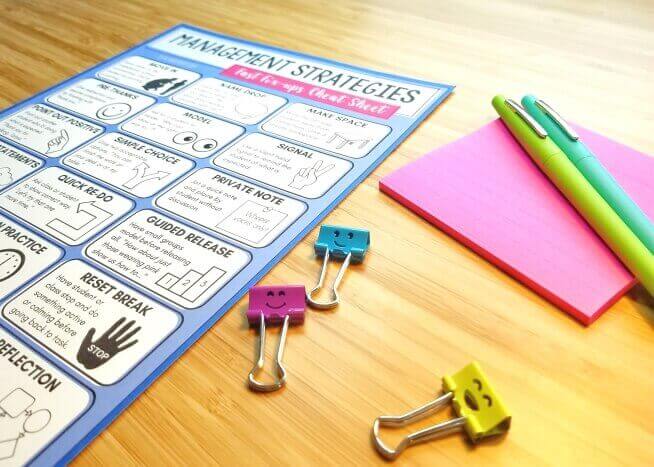Many teachers struggle with grading in K-5. What should be graded? How many grades should be given? How should work be scored? How can I get it all done? These grading tips (and free resources!) for elementary teachers will help you prioritize and simplify your grading practices to save time and enjoy better student results. Consider:
- How much time do you spend grading?
- How do you decide which work to grade?
- Do your students’ grades truly reflect their mastery of the standards?

Grading Tip #1: Know Your Purpose
We don’t grade work for the sake of grading work. We grade work to give students and parents feedback on the mastery of learning goals, and to inform ourselves of students’ progress as a guide for our instruction. When you keep these purposes at the front of your mind, it’s easier to separate what matters from what doesn’t and to simplify your grading practices. As an elementary school teacher, what is your purpose for grading work?
NOTE: You might feel that grades are also given to show the student’s effort, attitude, and work habits. Although this absolutely comes into play, I believe that grades should reflect mastery of skills. I use other means to communicate about effort, attitude, and work habits such as weekly student reflections that parents sign and return, notes on student work, and emails to parents.
Grading Tip #2: Plan Ahead
If you take grades randomly or decide what to grade “on the fly,” you’ll waste precious time grading work that just doesn’t need to be graded. Instead, plan ahead! When you are clear on your learning goals (and know how students will show mastery), it’s easier to focus your teaching and avoid unnecessary grading. For every unit, ask yourself:
- What are the learning goals and focus standards of this unit?
- What assessments will best measure student mastery of these goals?
Your assessment might include a multiple-choice or short-answer test, an essay, a project, or some combination of these, but the tasks should be linked to the specific learning goals.
NOTE: You might feel that you need to offer multiple opportunities for students to demonstrate mastery during a unit, leading to additional graded assignments throughout. Consider providing more opportunities for feedback and support instead of more opportunities for graded work. *See Tip #4
Grading Tip #3: Grade to Assess Mastery (Not to Document Work Completion)
Sometimes, we simply grade too much. But not every assignment needs a grade! I’ve heard teachers say, “If students did the work, I should give the grade.” Why? Think back to your purpose for grading. When you recognize grades are meant to give feedback on the mastery of standards instead of just the completion of work, you can start being more choosey with your grading.
Things that don’t need a grade:
- Any type of practice work (math worksheets, ELA skill practice, etc.)
- Any type of daily work or review (morning work, unit reviews, etc.)
- Formative assessments (mini-assessments meant to give feedback on current progress toward learning goals, such as exit tickets, reflections, short quizzes, etc.)
- Homework
Things worth grading:
- Mid-Unit and End-of-Unit Assessments
- Culminating projects where students apply learned skills
- Final essays
- Process (For example, if we’ve been learning about the writing process and students are meant to pre-write, draft, revise, and edit, it makes sense to grade how well they utilized each step)
NOTE: Some schools or districts require a certain number of grades for each quarter and subject-area. Although I believe that five or so grades per subject-area/quarter is plenty to inform parents and students of progress on those standards, I’ve sometimes been required to include up to 10. In these situations, you might consider making important assessments or projects count for two grades. For example, on a big writing piece or project, I might give one grade for the student’s process and another grade for their final project or paper. Or if students will be taking a fairly long test, you might break it up into two different tests for a two different grades.
Grading Tip #4: Get Organized
Searching for papers and entering grades can take up so much time. Make sure you have a system that simplifies the process. Here’s what works for me:
- Group Assignments: Grading in batches helps you work more efficiently. If students are turning in work at different times, collect each assignment in a different spot or sort them before grading.
- Use a Recording Sheet: Grading a paper and then entering the grade into the computer one at a time is tedious and time-consuming. Instead, print out a simple table with your students listed in alphabetical order (matching the grade book) on the left and a blank space for the assignment at the top. Fill in the grades on the sheet as you grade the assignments. Now, you can open your grade book on the computer and quickly fill in the scores as you move down the column. *This method is also helpful because you can highlight or circle any missing assignments!
- Enter Only Once: Whenever possible, wait until you have all of the assignments from one set graded before taking the time to enter them into the computer. Going back to input random grades wastes time. (If you have late work this isn’t always possible, but try when you can.)

Grading Tip #5: Give Feedback Instead of Grades
If the purpose of a given assignment is to practice or learn a skill, consider providing feedback rather than grading the work. There are so many quick and powerful ways to give feedback without sitting down to check and grade each assignment.
- Spot Checks: I use “spot checks” for things like daily skill review, where I want students to practice skills, but don’t have time (or a need) to grade each item. Let’s say the daily math review has 10 problems covering different skills. On Monday, I might go over 2 random problems with the whole class and have students check their own work and make corrections. On Tuesday, we’ll spot check two different skills.
- Instant Feedback: Use technology tools or simple student whiteboards to give feedback on any type of multiple-choice or short answer work. Just have students share their answers using a tech tool like Kahoot, or write their answers on a personal whiteboard to share. Give immediate feedback and have students self-assess their work.
- Partner Checks or Peer Review: Have students partner up to compare answers. If answers differ, the conversation in determining the right answer provides a wonderful learning experience.
- Simple Scores: Teach your students a simple scoring system, such as a 1, 2, 3 rating or check plus, check, check minus. Explain what each descriptor means (1 means you have not met the goals and need improvement, 2 is good progress but not quite there yet, 3 means you’ve mastered the goals). For less important assignments, give quick feedback by scoring papers with your chosen system.
- Personal Reflections: It’s not always the teacher’s job to tell students how they are doing. Sometimes, we need the students to do their own thinking work about their progress. For many assignments, especially writing and math, I like to have students write a short reflection on the bottom of the work, explaining their process and what they think they did well and could improve.
Grading Tip #6: Teach the Meaning of Grades
Try asking your class, or even an individual student, what a grade of 80 means. What does a C mean? Most don’t really know.
I’ve had students come up to me with a 70 on their paper and ask, “Did I do good?” while another with a 95 is crying and saying “I’m not smart” because they didn’t get a 100. There is often confusion among parents, as well.
Make a point to help students (and parents) understand the meaning of grades and what they say about students’ mastery of skills. I use the chart below in my classroom, and share a similar one with parents, to build a shared language around the meaning of grades. Your interpretation of grades might be different, but what matters is that you and your students and parents are on the same page. You can download this chart for FREE in my TpT Store.

Grading Tip #7: Manage Missing Work
One of the biggest time-wasters with grading is missing work and late assignments. To tackle this problem, try using a weekly routine to help students (and you) stay up-to-date on assignments and grading.
I do this by holding a Friday “Ketchup and Pickles” time each week. (Click here for free board signs.) This weekly half-hour or so is reserved for students to finish up work from the week, take care of any missing assignments, and retake assessments while I meet with any students about missing work or work that needs to be redone. Anything that is not finished up during this time (aside from assessments) is asked to be completed over the weekend and returned by Monday.
This routine helps me avoid wasting time tracking down missing work and figuring out why there are blanks in my gradebook.
Grading Tip #8: Use Tech Tools
There are so many incredible tools to help teachers save time when grading. Explore what your school or district has to offer! Here are a few examples:
- Canvas: If your district uses Canvas, try out their built-in quizzes. You can create your own multiple-choice quizzes that students complete online, and once they submit their work, it’s graded instantly! You can even allow retakes.
- IXL: This online platform includes practice problems, review, or assessments for Math, Reading, Science, and Social Studies. If you have access through your school or district, students can complete activities online and you’ll be able to monitor their progress.
- Zip Grade: Print scantrons for any assessment and use the app to grade instantly. (Free for up to 100 papers a month)
- Formative: Transform a PDF or Google Doc into an autograded assessment. (Free for basic level.)
By planning ahead and staying clear on your goals, it’s possible to streamline your grading practices and save an enormous amount of time and energy. Feel free to share your personal tips and tricks below!














